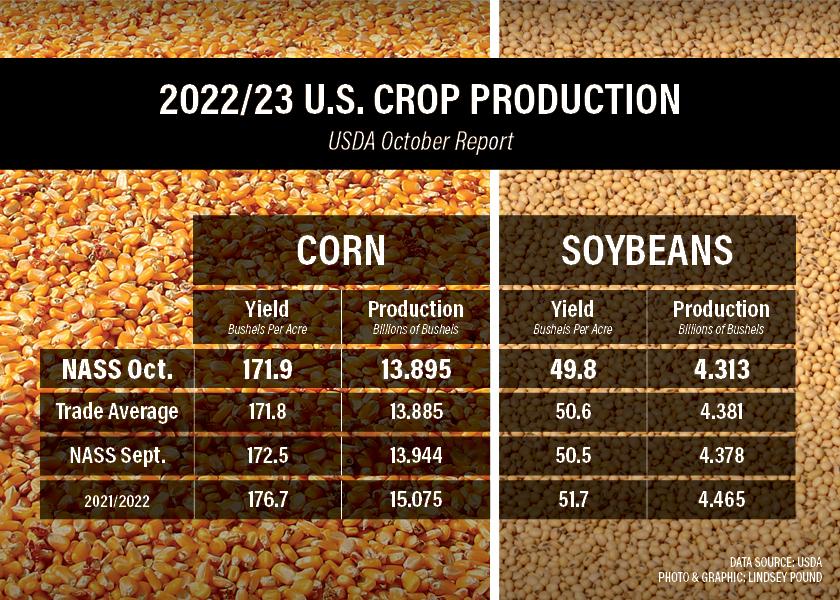Did the Yield Drops in USDA's Reports Put a Floor Under Grain Prices?

The U.S. corn and soybean crops keep getting smaller. Production for both crops is down from September 2022, according to the Crop Production report issued Oct. 12 by USDA’s National Agricultural Statistics Service.
Corn yields are expected to average 171.9 bu. per harvested acre, down 0.6 bu. from the previous forecast and down 4.8 bu. from 2021. Area harvested for grain is forecast at 80.8 million acres, unchanged from the previous forecast. As a result, corn production is down 8% from 2021, forecast at 13.9 billion bushels.
For soybeans, yields are expected to average 49.8 bu. per acre, down 0.7 bu. from the previous forecast and down 1.9 bu. from 2021. Area harvested for beans in the U.S. is forecast at 86.6 million acres, unchanged from the previous forecast but up slightly from 2021. This means soybean production is forecast at 4.31 billion bushels, down 3% from last year.
“The USDA report was certainly NOT bearish with the drop in yield estimates for both corn and beans,” says Jon Scheve, president of grain for Superior Feed Ingredients. “Historically speaking, when USDA has dropped the yield estimate in September and October, there is better than a 60% chance they will drop the yield again in the January report.”
As a result, Scheve says, this report likely put a floor under prices the balance of the calendar year.
While analysts ahead of the report were expecting a drop in corn yield, the soybean yield decline was not expected, says Bill Biedermann, AgMarket.Net co-founder, and the market responded quickly.
“That was a surprise that created a supply drop by 65 million bushels,” he says. “However, it did offset the more soybean stocks USDA found in the last quarterly grain stocks report. So, it was a net loss of 30 million bushels.”
USDA lowered demand and left soybean ending stocks unchanged.
“That means we don’t have a plentiful supply,” Biedermann says. “That’s only a 4.5 stocks-to-use ratio, which is only 16 days’ worth of supply. So even though it was a bearish demand revision, it's still a very tight situation.”
This is the tightest stocks-to-use ratio for soybeans since 2013, Scheve adds.
“Following the harvest in 2013, beans saw a dramatic rally in futures in the winter,” he says.
Will Corn Prices Rally This Winter?
For corn, USDA lowered exports by 125 million bushels and lowered ethanol use by 50 million bushels. However, USDA increased feed and residual use by 50 million bushels. With supply falling more than use, corn ending stocks for 2022/23 are cut 47 million bushels.
For USDA to drop corn ending stocks below 1.2 billion bushels, which they established as the pipeline requirement in 2022, is quite a statement, Biedermann says.
“We're down to an 8.2% stocks-to-use ratio, which is only a 30-day supply of corn on hand,” he says. “So, if we don't see further cuts in demand, or revision upward in yield, this market is going to be extremely buoyant if there's any kind of a problem in South America.”
Scheve says the current stocks-to-use ratio for corn is equal to the 2020 crop year.
“That was when the market had one of the best post-harvest rallies of all time,” he says.
Future Grain Price Drivers
The market will now start focusing intensely on South American weather, Scheve says.
“The world stocks are still tight and there is a real need for good production levels to be attained to push prices lower,” he says. “With the threat of La Nina present until after the new year, it leaves the South American crop with elevated chances of reduced yield and higher prices.”
Obviously, Scheve adds, demand destruction could still hurt a post-harvest rally for either crop and the Mississippi River’s low water levels will continue to be monitored to see what effects it could have on export pace.
The next 30 days will be important for the grain markets, Biedermann adds.
“I think USDA is trying to figure out how to balance the books and not cause fear and panic in the marketplace and on either side of it,” he says. “They're shooting right down the middle, which they should do until they see more statistics on how we come out. We need more yield data coming in, and we need to see how this economic macro picture and how the river system picture looks 30 days from now.”







